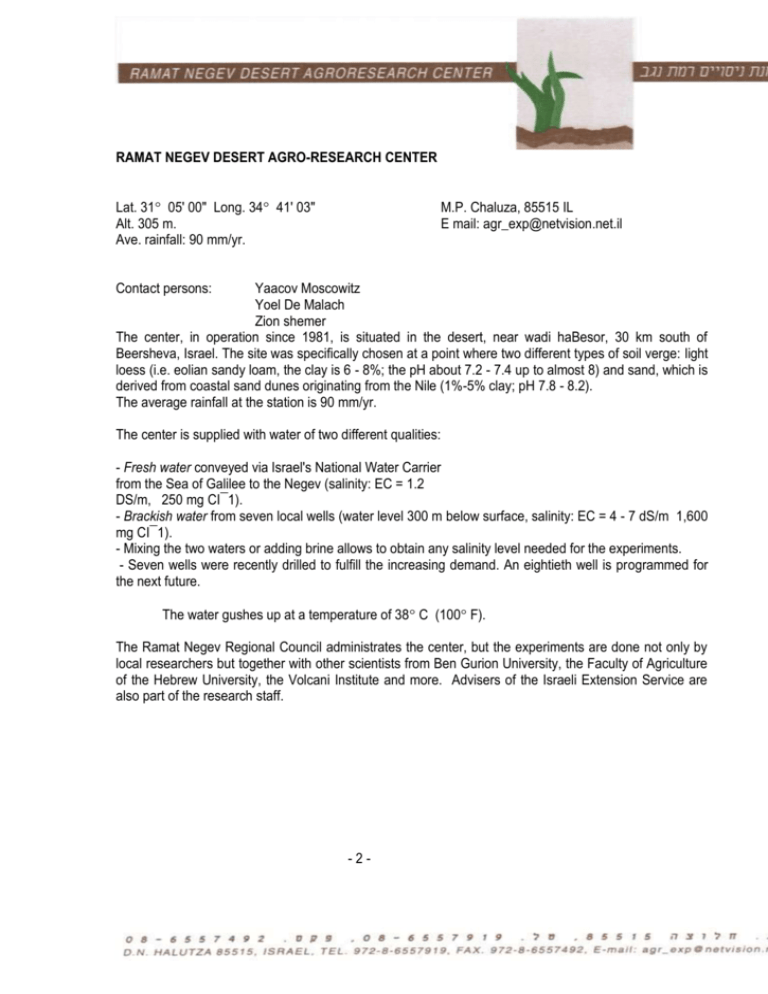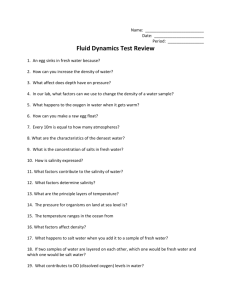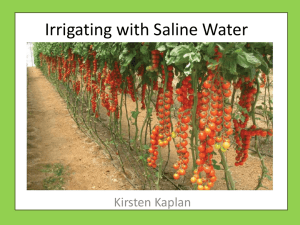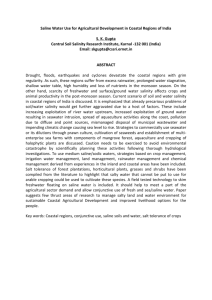About The Ramat Negev Desert Agro
advertisement

RAMAT NEGEV DESERT AGRO-RESEARCH CENTER Lat. 31 05' 00" Long. 34 41' 03" Alt. 305 m. Ave. rainfall: 90 mm/yr. M.P. Chaluza, 85515 IL E mail: agr_exp@netvision.net.il Contact persons: Yaacov Moscowitz Yoel De Malach Zion shemer The center, in operation since 1981, is situated in the desert, near wadi haBesor, 30 km south of Beersheva, Israel. The site was specifically chosen at a point where two different types of soil verge: light loess (i.e. eolian sandy loam, the clay is 6 - 8%; the pH about 7.2 - 7.4 up to almost 8) and sand, which is derived from coastal sand dunes originating from the Nile (1%-5% clay; pH 7.8 - 8.2). The average rainfall at the station is 90 mm/yr. The center is supplied with water of two different qualities: - Fresh water conveyed via Israel's National Water Carrier from the Sea of Galilee to the Negev (salinity: EC = 1.2 DS/m, 250 mg CI¯1). - Brackish water from seven local wells (water level 300 m below surface, salinity: EC = 4 - 7 dS/m 1,600 mg CI¯1). - Mixing the two waters or adding brine allows to obtain any salinity level needed for the experiments. - Seven wells were recently drilled to fulfill the increasing demand. An eightieth well is programmed for the next future. The water gushes up at a temperature of 38 C (100 F). The Ramat Negev Regional Council administrates the center, but the experiments are done not only by local researchers but together with other scientists from Ben Gurion University, the Faculty of Agriculture of the Hebrew University, the Volcani Institute and more. Advisers of the Israeli Extension Service are also part of the research staff. -2- The aim is to provide after literature searches, answers to the immediate needs of the local farmers, when necessary, through experimentation. Coordinately the intention is to apply the technology developed, and transfer the knowledge gained to any place especially developing countries, facing similar agricultural problems. The brackish water irrigation and its effect on the products' quality are the largest research project of the Center. Other projects: use of geothermal waters, utilization of the sand dunes common in the region and animal husbandry ( milk cows, fish, shrimps, ostriches, cattle, goats etc.) Research Specifically, research and development activities focus on the following: Greenhouse vegetables: The geothermal energy is used in protected agriculture to heat plastic houses. The vegetables are grown using brackish water to improve their quality and geothermal hot water for heating in winter. The prototype of an innovative type of green houses heated by solar energy is in its second year of experimentation. The desert sun in winter contributes to the success. Open field vegetables: The resistance to salinity of different varieties of more then 25 crops was tested. Melons on sandy soils and tomatoes in greenhouses are presently grown on a large scale and peppers are under study. A clear improvement in quality of many fruits was detected, especially in sugar content, taste and shelf life. A project to grow strawberry nurseries free of Colletetrichum, a common disease in northern and central Israel, was developed on a large scale. We are on the way to try to improve also strawberries’ taste by saline irrigation. Flowers and ornamentals: Growing flowers, flower bulbs with fresh, brackish and hot water under plastic cover especially in winter is also under study. Fruits: Many different orchard species were tested for salinity resistance: olives, pears, almonds, grapes, pomegranates, jujube, argania nuts, etc. Nowadays grapes for wine production are under study at the center and near Sdeh Boker. Following the success commercial olive orchards are planted on hundreds of acres all over our region. Ben Gurion University is testing some foreign fruit trees, with the aim of developing new crops suitable for Israel's growing conditions and for the tastes of the local and European market. -3Forage: Many different forage plants resistant to salinity were selected and some of them definitely improved milk production of local cows. A project for raising meat cattle was started. Animal husbandry: Fish, ostriches, shrimps, goats and sheep are raised and constantly supervised by the center experts and advisers. More dairies are brought to our region from Central Israel to exploit the climate that was found extremely beneficial to the animals. Methods Various approaches are used at the station to overcome the salinity stresses. - Physiologists study the period of maximum susceptibility of the plants to alleviate their suffering: small amounts of fresh water are given at the most sensitive moment. The influence of nutrients and micro-elements on the quality of the products is under study. - Pedologists monitor the way of leaching soils from accumulated salinity and study optimal quantities and proper intervals of irrigation. - Plant nutrition: Another approach is to study how to alleviate the salinity stress by different, more apt fertilizers’ quantities and qualities. There is continuous monitoring and adjustment and the system adds the proper amount of fertilizer. - Geneticists. Develop cultivars resistant to saline irrigation and fit to the American and the European taste, crossing superior varieties with resistant genotypes from different saline environments - Irrigation systems. Drip irrigation is the breakthrough that allows cultivation of crops also with brackish and saline water. It ensures a continuous flow into the soil that maintains a proper constant dilution of the soil solution. It allows frequent irrigation to keep the salts concentration of the soil solution constantly low. - Technical approaches are most important. Computers for irrigation of the type suitable for small farmers are used. Solar energy is used to recharge their batteries, so that a supply of electricity in the field is not needed. One main line supplies fresh water and the other saline water. -4The task of the computer is to control the timing of irrigation, the type of water used, the quality and quantity of fertilizers mixed with the water (fertigation) and the temperature in the greenhouses. In order to achieve a higher salt concentration brine can be introduced into the fertilizer reservoir. A computer for mixing saline and fresh water to maintain constant desired levels of salinity was also developed. A sophisticated system for a rapid selection of the salinity resistance of rootstocks and other plants using drip irrigation was developed. Aquaculture. A sophisticated method for super-intensive fish cultivation using warm water, plastic covered ponds and an organic filter to clean the recycled water was developed. Results Saline water irrigation almost always requires the drip method. Irrigating up to 6 times a day in sandy soils resulted in high yields of many crops without increasing the water total amount even on sandy soils, where proper aeration is assured. Leaching is required from time to time. Local conditions and proper management allow easy leaching of salts, if necessary. No pluriannual accumulation was detected. It was found that using fresh water only during short periods of the plant being sensitive to salinity (and brackish water at other times) is a better approach than mixing water of different qualities to apply a constant lower salt concentration during the entire season. In general, saline irrigation results in a lower fresh weight yield than that of a fresh water irrigation but the difference in the dry weight yield is much smaller. For example, sugar beets irrigated with saline water produce less tonnage but almost the same quality of pulp as those irrigated with fresh water. This means that there is less work in harvesting, transporting and processing. Canneries pay the farmers according to the dry matter content, not according to the fresh weight. We may say that the most important achievement of our research was the organoleptic amelioration of our products following the brackish irrigation: tomatoes, melons, olives, pears, wine-grapes, etc. The Desert sweet tomatoes and melons are now known in many foreign countries. The results of the studies at the center are currently being used by Negev, Israel and several other countries' farmers. An increasing interest about the work and about the results obtained at our center is expanding all over the world. The Ramat Negev Regional Council has recently started the process of setting up an international center for studying desert agriculture. The purpose of the center: training students in advanced agricultural work in desert areas using brackish or marginal water. This center will absorb students from various countries, who will combine practical work at one of the local farms or at the Experimental Center, along with their studies in the learning center. This center will work in complete cooperation with the academic institutions or colleges from their home countries, and the students’ practical work will be considered as part of their final project at their home college or university. The main goal of the center is actually to train students from various countries in which agriculture is not developed, and these students, after training, will be able to provide guidance to the farmers in their home countries.







